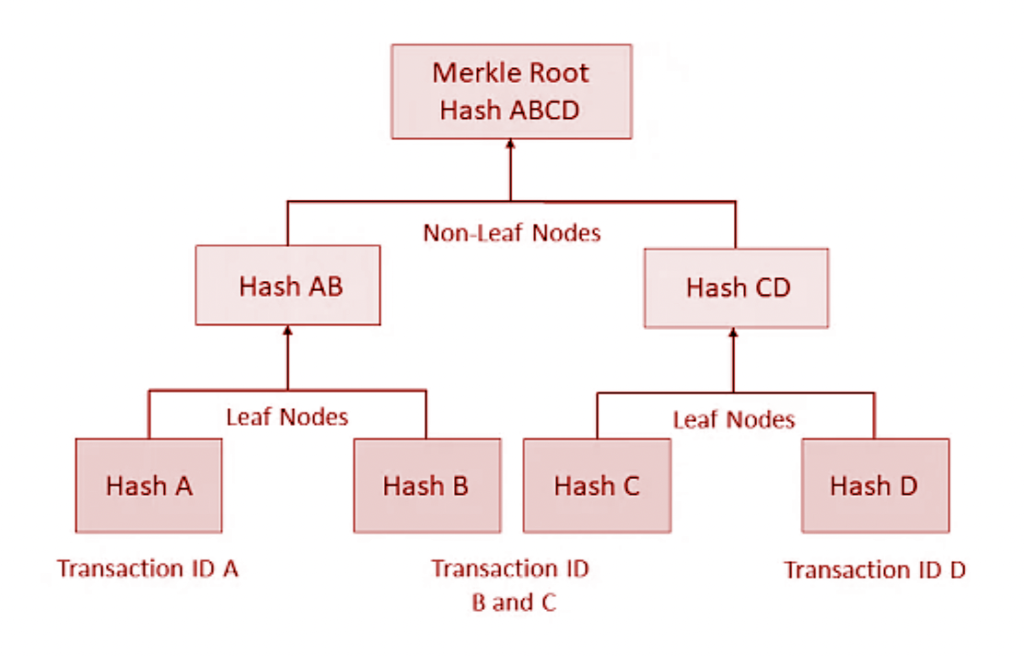Blockchain technology has flipped the finance world on its head, yet amid the crypto buzz, a critical component often slips under the radar: the Merkle Tree. While flashy terms like mining algorithms and consensus mechanisms often steal the spotlight, Merkle Trees quietly serve as the unsung heroes of blockchain. They ensure data integrity and security across decentralized networks.
- So, what exactly is a Merkle Tree?
- Solving the Decentralization Dilemma
- How Merkle Trees Work
- Applications of Merkle Trees in Blockchain
- Bitcoin: Pioneering Merkle Tree Efficiency in Blockchain
- Ethereum: Expanding Merkle Tree Applications
- Other Blockchain Platforms Leveraging Merkle Tree Efficiency
- Advantages of Using Merkle Trees in Blockchain
- Efficient Data Verification
- Enhanced Scalability
- Powerful Security
- Optimized Data Management
- Support for Light Clients
- Challenges and Limitations of Merkle Trees in Blockchain
- Conclusion
The integration of Merkle Tree efficiency in blockchain technology, particularly in cryptocurrencies like Bitcoin and Ethereum, has definitely cemented their status as a fundamental component of modern cryptography. Beyond the technical jargon and complex algorithms lies a simple truth—Merkle Trees are indispensable for maintaining the trustless nature of blockchain.
Merkle Trees are a fundamental component of blockchain technology, enabling efficient and secure data verification. As a rule of thumb, they ensure data integrity by organizing transactions into a tree structure, where the Merkle Root serves as a unique fingerprint, detecting any tampering with the underlying data.
In this article, we’ll walk through the inner workings of Merkle Trees and their specific applications in blockchain technology.
So, what exactly is a Merkle Tree?
At its essence, a Merkle Tree is a data structure that arranges information in a hierarchical, tree-like format. This setup allows for efficient and secure verification of data within extensive datasets. Named after its creator, Ralph Merkle, this data structure has become a key element in various cryptographic systems, including blockchain technologies.

A Merkle Tree consists of multiple nodes, with each leaf node representing a hash of a data block, and each non-leaf node representing a hash of its child nodes.
At the very top, a node called the Merkle Root, encapsulates all the data within the tree, providing a unique identifier for the dataset. This structure is inverted compared to typical trees, with the root at the top and leaves at the bottom.
Well, think of it this way. You don’t need the whole fruit basket just to taste one apple. Similarly, Merkle Trees lets you verify the integrity of a piece of data without needing the entire database. Isn’t that smart?
The real power of a Merkle Tree lies in its ability to enable users to verify data integrity with minimal information.
Rather than needing access to the entire dataset, one can confirm that a specific piece of data belongs to the set by examining only a small portion of the tree—essentially a “proof” that traces a path from the leaf node to the root. This efficiency is particularly valuable in decentralized systems, like blockchains, where information is spread across multiple nodes.
Solving the Decentralization Dilemma
An incredibly major challenge in decentralized networks, such as blockchain, is efficiently managing and verifying data across multiple nodes. In centralized systems, data stored in a single location is relatively easy to verify and maintain. However, in decentralized networks where data is replicated across numerous nodes. Which means it ensures data integrity becomes significantly more complex.
You know, here’s a neat trick, Merkle Trees offers a smart and beautiful solution to this issue. By organizing transactions into a tree structure, blockchains use Merkle Roots to verify the integrity of large datasets swiftly and efficiently.
This approach not only cuts down on the data that needs to be stored and processed but also boosts network security by making it extremely difficult to alter past transactions without detection.
For example, in Bitcoin, each block contains a Merkle Root summarizing all transactions within that block. When a new block is added to the blockchain, its Merkle Root is included in the block header, which is then used to verify the block’s integrity. If even a single transaction within the block were altered, the Merkle Root would change, indicating tampering.
This verification method is not only efficient but also scales logarithmically with the number of transactions. As the number of transactions increases, the computational effort required to verify the block increases at a much slower rate. This scalability is a key reason why Merkle Trees are so effective in blockchain technology.
How Merkle Trees Work
Now that we’ve established what a Merkle Tree is and its significance in blockchain technology, let’s delve into its mechanics. Understanding the inner workings of a Merkle Tree involves exploring its structure, the hashing process, and how it efficiently ensures data integrity across a decentralized network, shall we?
The Structure of a Merkle Tree
A Merkle Tree is a binary tree, where each node has at most two children. The structure begins with the leaf nodes, the lowest level representing individual pieces of data—typically transaction hashes in the blockchain. Moving up the tree, each non-leaf node is a hash of its child nodes, culminating in the topmost node, known as the Merkle Root.
By the way, here’s a fun fact! Each level of the tree acts like a checkpoint so as to confirm the authenticity of the information below it.
- Leaf Nodes: These are the starting points of the Merkle Tree. In a blockchain, each leaf node contains the hash of a single transaction. For example, with four transactions A, B, C, and D, each would be hashed to produce four leaf nodes: H(A), H(B), H(C), and H(D).
- Non-Leaf Nodes: These are created by hashing pairs of leaf nodes together. For instance, H(A) and H(B) would be concatenated and hashed to produce H(AB), and similarly for H(C) and H(D) to produce H(CD).
- Merkle Root: The top of the tree is the Merkle Root, a single hash representing the entire dataset. In our example, the Merkle Root would be H(ABCD), derived from hashing H(AB) and H(CD).
This hierarchical structure is both efficient and resilient. Any change in a single transaction will propagate up the tree, altering the Merkle Root and signaling data tampering.
The Hashing Process
Hashing is fundamental in constructing Merkle Trees. A hash function takes an input of any size and produces a fixed-size string of bytes, typically a hexadecimal number. This process is deterministic, meaning the same input always produces the same output, but even the smallest change in input produces a vastly different hash.
Let me explain you in a nutshell. So basically what happens is that in blockchain systems like Bitcoin, the SHA-256 hash function is used. This function takes each transaction and hashes it to produce a 256-bit number. These hashes are then combined in pairs and hashed again to form the next level of the tree.
Applications of Merkle Trees in Blockchain
Merkle Trees are foundational to blockchain technology, serving as a cornerstone for transaction verification and data integrity. This section explores the diverse applications of Merkle Trees in blockchain, stressing their efficiency and specific use cases in Bitcoin, Ethereum, and other platforms.
Bitcoin: Pioneering Merkle Tree Efficiency in Blockchain
Bitcoin, the first major cryptocurrency, pioneered the implementation of Merkle Trees in blockchain. The Merkle Tree structure plays a crucial role in organizing transactions within blocks and ensuring their verifiability.
- Block Verification: Merkle Trees enable efficient verification of transactions within a block. Nodes can quickly validate all transactions by checking the Merkle Root against the block’s contents.
- Simplified Payment Verification (SPV): Merkle Tree efficiency in blockchain allows lightweight clients to verify transactions without downloading the entire blockchain, crucial for mobile wallets and similar applications.
- Tamper-Proofing: Merkle Trees enhances security by making transaction alterations detectable, ensuring blockchain integrity.
Isn’t it amazing how such a simple concept can bring such wonderfully powerful security? Bitcoin’s implementation showcases how Merkle Trees creates a secure, efficient, and scalable system for managing decentralized transactions.
Ethereum: Expanding Merkle Tree Applications
Ethereum expands on Bitcoin’s use of Merkle Trees by implementing a more complex variant called the Merkle Patricia Tree. This structure enhances Merkle Tree efficiency in blockchain by managing not only transactions but also account states and smart contract data.

- State Management: Merkle Patricia Trees stores and verifies account states, including balances, contract codes, and storage, enabling efficient state verification at any given time.
- Transaction Verification: Similar to Bitcoin, Ethereum uses Merkle Patricia Trees to organize and verify block transactions.
- Smart Contract Execution: Merkle Trees play a crucial role in managing and verifying state changes resulting from smart contract executions, ensuring accuracy and tamper-resistance.
Ethereum’s implementation demonstrates the versatility of Merkle-based structures in handling complex data types within blockchain networks.
Other Blockchain Platforms Leveraging Merkle Tree Efficiency
While Bitcoin and Ethereum are prominent examples, numerous other blockchain platforms harness Merkle Tree’s efficiency to enhance their security, scalability, and functionality. Let’s have a look at them, shall we?
Hyperledger Fabric: Enterprise-Grade Merkle Tree Applications
Hyperledger Fabric, a permissioned blockchain platform, utilizes Merkle Trees to ensure
- Ledger integrity
- Efficient state verification
- Enhanced auditing capabilities
- Crucial for enterprise applications requiring high trust and security
Zcash: Privacy-Focused Merkle Tree Innovations
Zcash, a privacy-centric cryptocurrency, employs specialized Merkle Trees to
- Improve transaction privacy
- Allows verification without revealing sender, receiver, or amount details
- Balances transparency with confidentiality
Corda: Business-Oriented Merkle Tree Solutions
Corda, designed for business applications, leverages Merkle Trees for
- Contract and transaction management
- Partial transaction verification without full disclosure
- Enhances data privacy in business environments
- Facilitates efficient contract state management
Let me tell you about the other innovative Merkle Tree applications in blockchain, including:-
- Stellar: For efficient transaction history summarization
- IOTA: Implements for IoT applications
- Polkadot: Utilizes in its relay chain for cross-chain interoperability
These diverse implementations showcase the versatility of Merkle Trees, you know, across various blockchain ecosystems. By leveraging Merkle Tree efficiency, these platforms address specific challenges in their respective domains, from enhancing privacy to improving scalability and interoperability. Isn’t that something?
Advantages of Using Merkle Trees in Blockchain
They play a very important role in mitigating transaction malleability, a vulnerability where attackers can modify transaction IDs before confirmation. You know, this attack can disrupt the verification process and create confusion in the blockchain.
Merkle Trees, which rely on these IDs to maintain data integrity, provide a powerful defense mechanism. Any tampering with transaction IDs alters the Merkle Root, immediately signaling data compromise.
By swiftly detecting such inconsistencies, Merkle Trees help maintain blockchain security and integrity, which means that making them indispensable in protecting against transaction malleability and similar threats.
Other than this, it offers several key benefits—
Efficient Data Verification
They enable quick validation of an entire block’s integrity through the Merkle Root, without checking each transaction individually.
Enhanced Scalability
By minimizing data storage and processing requirements, Merkle Trees support the efficient growth of blockchain networks.
Powerful Security
Utilizing cryptographic hashing, they provide a tamper-evident structure, making data alteration easily detectable.
Optimized Data Management
Merkle Trees streamline storage and retrieval processes, which is crucial for decentralized systems with limited resources.
Support for Light Clients
They allow for partial verification, enabling lightweight nodes to operate effectively without storing the entire blockchain.
Challenges and Limitations of Merkle Trees in Blockchain
Despite their advantages, Merkle Trees face several challenges in blockchain implementation—
Computational Complexity
As blockchains grow, creating and verifying Merkle Trees becomes more resource-intensive.
Implementation Difficulties
Integrating Merkle Trees into complex blockchain systems like Ethereum can be technically challenging.
Scalability Trade-offs
While they improve overall scalability, very large Merkle Trees can still impact performance in some scenarios.
Security Vulnerabilities
Issues like block malleability and potential quantum computing threats pose risks to the integrity of Merkle Tree structures.
Addressing these challenges is crucial for maintaining the effectiveness of Merkle Trees in blockchain systems as the technology continues to develop.
Conclusion
Merkle Trees stand as a cornerstone of blockchain technology, far surpassing their role as a mere technical component. Since their conception by Ralph Merkle, they have become integral to the security, scalability, and efficiency of decentralized networks, finding widespread adoption in cryptocurrencies like Bitcoin and Ethereum.
Let’s wrap it up! In decentralized systems, Merkle Trees provide the critical structure for maintaining data integrity and enabling efficient verification. They allow blockchain networks to grow effectively, supporting increased users and transactions without compromising performance.
Merkle Trees continues to evolve, addressing emerging challenges such as quantum computing threats and integration with IoT and AI. Also, issues of computational complexity, security vulnerabilities, and scalability require continuous innovation and adaptation.
Despite facing challenges, the importance of Merkle Trees in blockchain’s evolution is undeniable. They ensure trust, verification, and security across global networks of participants. This efficient data structure, born in the late 20th century, has become a linchpin of 21st-century decentralized technology.


















